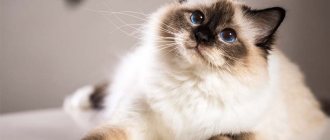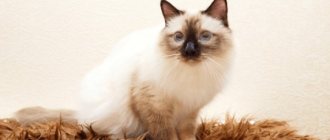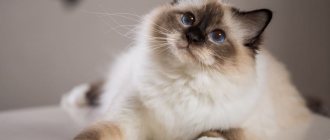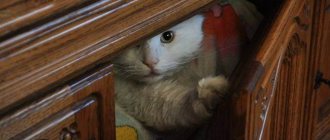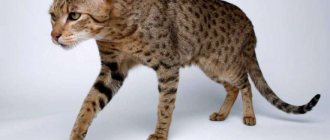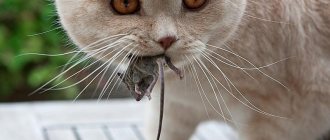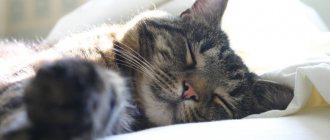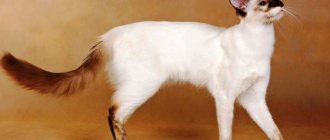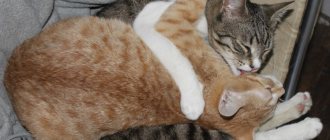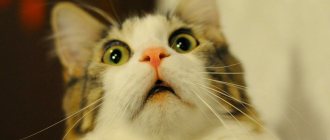A cat with a fluffy Persian “fur coat” of the color of a Siamese aristocrat, a soft, almost angelic character and an innate sense of dignity—is it just an amazing hybrid or a dream of a cat lover-aesthete? No more no less in front of you sacred burma. The famous fashion designer Karl Lagerfeld discovered his muse in one of the cats of the sacred Burmese breed. What is the animal that is being looked after by three specially trained maids? What secret does the sacred Burmese cat hide?
Key facts
The official name of the breed is the Burmese cat, or sacred Burma. The name is based on the country of origin - a state in Southeast Asia called Myanmar. Burma is its former name, popular among foreigners and lasting until 1989. In English pronunciation this word sounds like “Burma”, which often misleads people. The Burmese and Burmese cat breeds do share a common country of origin, but have completely different appearances. The description of the Burmese cat includes having long hair and a color-point coat, while the Burmese's coat is short and darker.
The average lifespan of a Burmese cat is 15 years. She has good health and a balanced character. The greatest friendliness is characteristic of males. They quickly find a common language with other animals, enjoy playing with children and are not afraid of strangers.
Among the key characteristics of the Burmese cat breed, it is important to note extreme curiosity and perseverance. These animals know how to achieve their desires, so sometimes they are too annoying.
One of the most famous Burmas is the Choupette cat, which belonged to the German fashion designer Karl Lagerfeld. After the owner's death, she inherited $200 million.
Photo
Everyone chooses a pet for themselves, assessing the beauty of the breed according to their own scale of beauty. World cinema star Romy Schneider, of all the purrs, preferred the Burmese cat. His name was Balzac de Ranchipur and this Burmese cat often posed in photos next to his famous owner.
And the singer Baptist Giabiconi gave the famous Karl Lagerzheld a Burmese cat. The cat's name is Choupette and she is famous all over the world. Not every pussy is looked after by three maids, recording every step in a special book, and Lagerfeld himself does not devote entire collections to each one. The designer himself believes that she is priceless and is not going to sell her, but fans are waiting for kittens from the famous pussy.
History of the origin of the Burmese cat
The exact country of origin of the breed is unknown, since the Burmese received its first official recognition in France in 1925. Felinologists suggest that the animals were brought from Myanmar by an American billionaire who took a cruise to eastern countries in 1919.
The man gave a considerable part of his fortune for two kittens, but only the girl survived the journey. It was she who became the founder of the European line. In the second half of the 20th century, furry animals were recognized by all felinological organizations.
It is believed that the appearance of the cats was achieved through matings of Siamese and Persians. Residents of Myanmar claim that mentions of these cats date back to ancient times and contain many interesting facts. One of them explains why animals are called sacred.
At the temples of the goddess Tsun Huan Ce, the guide of souls in the afterlife, with the death of some monks, black and white cats with golden eyes appeared. Buddhists believed that these were messengers of the goddess who had arrived to protect the temple, and treated them with special respect. One day, during an attack by robbers, one of the cats named Singh came to the defense of the monks. His fur glowed with a golden glow and his eyes changed color to bright blue. This scared off the bandits and helped defend the temple.
Breed characteristics
COUNTRY OF ORIGIN
Burma
EXTERIOR
A stocky cat with gorgeous fur. An elongated, strong body with good muscles and strong bones. The head is wide and slightly rounded, with a straight nose, full cheeks and a strong chin. The ears are wide at the base. The eyes are almost round, widely spaced, and always blue. Legs of medium length, muscular; paws are large and round. The tail is of medium length.
SIZE
Medium, closer to large.
COLOR
Beautiful medium-length silky coat, collar around the neck. Different felinological organizations allow different color options. Traditional colors are point, chocolate point, blue point, lil point. White “gloves” are required, as are white markings on the hind legs that resemble shoelaces.
PECULIARITIES
Gentle, quiet, pliable, loving cat.
What does a Burmese cat look like?
A photo of a Burmese cat shows an amazing resemblance to Siamese and Himalayans. This breed is suitable for those who are delighted with the Siamese color and Himalayan coat, but consider a thin body or flattened muzzle not beautiful enough. Along with its attractive appearance, a bonus to the Burmese is its docile and friendly character. The weight of these animals is 4-6 kg, and their height at the withers is about 30 cm. Boys are always larger than girls, so they usually weigh at least 5 kg.
Muzzle
The breed is characterized by a rounded head. Its width is slightly shorter than its length. The animal has a slightly convex forehead, rounded cheeks and a strong chin. According to the standards, 2 varieties of Burmese cats are allowed: with a pronounced stop for TICA and the absence of a transition from the muzzle to the “Roman” nose for FIFe. The calling card of the breed is its round, expressive sapphire-colored eyes. Their color varies from light blue to deep blue. Unlike other cats, blue eyes do not have a negative effect on hearing. The small ears are slightly tilted forward, rounded at the tips and pubescent on the inside.
Possible defects include squint, a different eye color, or the presence of a silvery sheen in them. An animal with such an appearance will be classified as a pet class and will not be allowed for breeding.
Body type
The head is located on a slightly muscular and wide neck. The body of the Burmese is squat and elongated, with powerful bones. The hind and forelimbs are thick and muscular. They end in round and strong paws with tufts of hairs between the toes. The raised tail is pubescent. Its knobbiness or curvature is unacceptable.
Coat and color
The animal's fur has no undercoat and resembles silk. On the belly, the hairs curl into a light wave, and on the neck they grow into a luxurious mane. The main color of the Burmese cat is color point. Unlike Siamese, the standard of this breed allows for all possible markings: chocolate, lilac, gray, red. The color of most of the coat varies from white to cream.
The dark markings present on the tail, ears, limbs and muzzle match the appearance of the Siamese. A distinctive feature of Burmese is considered to be white “socks” on all four paws. Their absence will result in disqualification. Defects also include points on the light parts of the coat and light marks on the points.
Owner reviews
- Marina : We have two cats with amazingly different characters, which manifest themselves in everything: Sonya is active and loves to walk. Hearing the command, he immediately runs to put on the harness. Harlequin defiantly lies down on the sofa, making it clear that at her advanced age, decent cats do not walk on a leash. During the trip, Sonya shows maximum activity and curiosity: she runs around the cabin and loves to look out the window. Harlequin sleeps in the carrier until the end of the trip.
- Tonya : The kitten quickly settled into our home and immediately found several secluded places where he could relax and play. Everyone immediately fell in love with him for his activity, love of the game and affectionate disposition. Never scratches small children and calmly endures all their squeezing. He mastered the litter tray and scratching post right away, and later learned to walk on a harness.
- Manyasha : Cats of the Sacred Burma breed are a little more than completely beautiful. They are simply amazing. Real kittens of this breed cost 600 euros. Yes, not a single breeder will give away a cat of this breed for free, because it is a real treasure. Burmas are difficult to breed. It is not surprising that professional breeders of this breed can be counted on one hand, and the requirements for the future owner are high.
Personality of the Burmese cat
If we talk about who is suitable for Burma, then it will be the elderly and owners with disabilities. These animals don't like noise. Loud screams of small children or frequent parties frighten them, negatively affecting their psyche. This breed also has an intolerant attitude towards loneliness. They quickly become attached to their owners and enjoy sitting in their arms.
The character of the Burmese cat is called balanced. She is characterized by playfulness and high intelligence. Despite the increased activity, the animal always keeps itself within certain limits. A furry pet will never offend a child, so it can suffer if handled incorrectly. She gets along well with other pets, but can become jealous if she notices that a person is paying more attention to them. Burmese owners claim that their pets can read their thoughts. Initially, this feature was noticed by Buddhist monks, who nicknamed the animals “the eye of heaven” for their piercing gaze.
One of the disadvantages of the breed is excessive obsession. It manifests itself when an animal wants something very badly. Excessive assertiveness can even make you angry, but you have to put up with this behavior. Your negative reaction or lack thereof will only offend Burma. In most cases, manipulation skills are used appropriately when the owner is in a good mood.
Breeding work
Enthusiasts of the breed, who are becoming more and more numerous in Russia, are trying not only to widely popularize the still quite rare Burmese cat, but also to preserve and improve its breed qualities as much as possible, expanding and qualitatively differentiating the gene pool of the sacred Burmese. Breeding work in this case must be well thought out, and responsibility for its results falls on the few nurseries that are still very numerous and value their reputation very much.
Preparing the Parent Couple
Along with the popularity of the Burmese cat, the number of producers whose combination of blood can be used in breeding work is also growing. The selection of the parent pair is extremely important for successful reproduction in this breed. Therefore, it is advisable to entrust this delicate topic to professionals, and not just breed your favorite cat “for health” with a cat who lives nearby.
A good parent couple means beautiful and healthy children
To organize a successful mating, you need to have a good knowledge of at least the genetics of colors, and even better - how prepotent the future parents are, what qualities they usually pass on to their offspring and how they can be improved.
The parent couple should begin to prepare for mating no later than a month before the “X-hour”. Both animals must be promptly vaccinated and freed from parasites. Don’t be shy to ask for a certificate about whether your animal’s intended partner is healthy—during mating, the risks of transmitting infection are high. In addition, there are many diseases that can become dangerous to the health and even the life of future babies.
Pregnancy and kittens
During the period of waiting for babies, the mystery of the Burmese cat fantastically increases many times over - probably as many times as the number of little lives the expectant mother is maturing in. At this time, she needs increased attention and care, tries to spend more time with her owner, receive confirmation of love from him - for Burmese, like any woman, such signs are important and necessary.
It is no coincidence that the Sacred Burma is called a female breed - out of the entire number of household members, this cat usually chooses the mistress as the main object of worship and service. And not during the pregnancy of the woman she loves, Burma will definitely take special protection over her. But this amazing cat expects a similar attitude towards itself.
This is how Burmese kittens are born
Burmese kittens, beautiful white balls of fluff, are born approximately nine weeks after the act of parental love. As befits all cat cubs, they are blind and deaf, and they are only interested in their mother - her warmth and her delicious milk. But somewhere around the third day of life, a completely helpless baby literally before our eyes begins to manifest his bright individuality - the kitten’s white fur gradually acquires its own unique colors and shades. Watching this mysterious process is extremely interesting.
The nose is painted first, the outlines of the mask appear on the muzzle, then the paws, ears, tail darken... By the age of two weeks, an experienced breeder of a kitten will already be able to guess what kind of adult animal this cute baby will turn out to be. Of course, genetically, you can try to assume this in advance, but nature in general is a big fan of presenting surprises to people, and the mysterious nature of the sacred cat is even more so.
Castration and sterilization
Sufficient indications for sterilization of a Burmese cat can be not only health problems, but also the conditions under which the breeder sells a pet-class kitten that does not have access to breeding for various reasons. In other cases, responsible veterinarians usually discourage owners of this breed from spaying or neutering their animals.
This cat loves you - love her back
The Burma is absolutely non-aggressive and is distinguished by adequate behavior even during periods of hormonal peaks. Sterilization is by no means a simple and harmless operation; moreover, it is performed under general anesthesia, which can negatively affect health. Before you decide to undergo surgery, weigh the pros and cons of the operation - it is likely that you can do without it.
Raising a Burmese cat
Many owners do not understand how to stop their pets from scratching and chewing their hands. This problem often occurs due to improper training and games. The owner's hands are made for affection. They give food and should never hurt.
Also try not to use them for gaming. The exception is playing under a blanket. Most cats are convinced that they are hunting the “duvet monster” and not the owner.
When raising a Burmese cat, use punishment based on its character. The most effective method of punishment is ignoring. The main thing here is to make sure that the pet understands the reason for such treatment. If he went to the toilet past the tray while you were at work, then any punishment is already meaningless. In such a situation, the lack of affection will frighten the animal, which is detrimental to the psyche.
Another effective method of punishment is a stream of water. Use it when teaching prohibition commands. Burms are smart creatures. They will quickly realize the relationship and begin to stop their actions at the word “no”, without waiting for being sprayed with water.
Don't try to create a trained animal by doing the same thing as dogs. Your task is to correct behavior and get a well-mannered pet who is familiar with the basic prohibitions in your home.
Burmese cat health
Burms are long-lived cats. One of them, Lady Catalina from Australia, is immortalized on the pages of the Guinness Book of Records: her life expectancy was 35 years.
Thanks to careful selection, the health of the Burmese cat turned out to be quite strong. With regular visits to the veterinarian, timely treatment for parasites and the availability of all necessary vaccinations, Burmese live longer than other breeds.
Possible diseases
Hereditary diseases of Burmese include hypertrophic cardiomyopathy, corneal dermoids and vestibular disorders. If detected early, they are all treatable.
Heart problems are easily recognized by shortness of breath and coughing that appears immediately after active games. The presence of a dermoid (a sac-like tumor on the white of the eye) is visible to the naked eye. Coordination problems manifest themselves in unsteady gait and other balance problems.
Reproductive health
To obtain offspring, only purebred partners with pedigrees are used. Mating with other breeds, mestizos and representatives of the pet class is strictly prohibited. Due to the small number of representatives, felinological organizations strictly control all matings and can punish violators with a fine.
Pregnancy is a difficult test for the body. Frequent births, more than 3 times in 2 years, are prohibited. For Burmese cats, the conditions are less strict - they can mate twice a month.
Burmese are record holders not only in age, but also in the number of newborns. They usually give birth to up to 10 kittens, but one representative managed to give birth to as many as 19 babies. Coping with such a huge offspring is not so easy, so veterinarians recommend not torturing yourself or the animals. Immediately after the appearance of sexual activity, pets can be scheduled for sterilization or castration. For representatives of the pet class, this is the most reasonable solution, since they are not allowed for breeding.
Hereditary diseases
The characteristics of the Burmese cat are positive, partly due to thoughtful selection. There are common types of genetic disorders that can be treated.
Pathology of the vestibular apparatus
Cats have a naturally weak vestibular system. Therefore, pets are slow, a little clumsy and can fall over when jumping. They should not be forced to jump high or left near an open window or balcony.
Tendency to catch colds
Heat-loving animals easily get sick from drafts. It is necessary to create a comfortable climate for them at 23-25°C. If possible, floors are covered with carpets. Beds and cat blankets are placed on small hills.
Important!
Also, animals have a problem with the sinuses. The holes are quite tiny, which causes them problems when they have a cold.
Corneal dermoid
This is a thin, growing film on the cornea. It blocks the pet's view, depriving him of quality vision. The problem is solved surgically. Vision is completely restored.
Hypertrophic cardiomyopathy
This pathology is typical for many breeds. It is expressed in thickening of the walls of the ventricles of the heart. The organ pumps less blood, which provokes heart failure and blockage of blood vessels. There is only one treatment - surgery.
There is a list of simple symptoms that help identify the disease:
- apathy and lethargy of the animal;
- constant shortness of breath;
- low body temperature;
- weight loss;
- mucous membranes become bluish in color.
Important!
To track the disease in its infancy, cats are given an ECG once a year.
Features of feeding and diet
The cost of keeping a Burmese is quite high, since it does not favor dry food and canned food. Natural feeding is often more expensive, since in addition to food you have to buy vitamins. It is also worth considering the fastidiousness of the animal. Before you understand what to feed your pet, you will have to sweat in trying to recognize his favorite dish.
Of course, there are advantages to owning a Burma. She never suffers from obesity, because she knows her norm. Purebred pets will not eat everything that is poured into a bowl if the feeling of fullness has already set in. When preparing your diet, follow the general recommendations:
- Choose lean meats: chicken, rabbit, turkey. Pork and lamb are harmful to the kidneys and liver. Protein should form the basis of the diet.
- Use natural fermented milk products. Milk can only be given to kittens. After 1 year of age, all adult animals develop lactose intolerance.
- Supplement your main diet with a small amount of cereals and vegetables.
- Avoid any products that contain natural or artificial colors. They can change the color of the fur coat to a darker shade.
Feed adult pets twice a day, leaving no more than 250 g of food at one time, and even less dry food. It is enough for kittens to give 150 g of food 4-5 times a day. Calculating portions is necessary to ensure that the food does not spoil in the bowl. Remember that natural products are removed immediately after feeding.
Care and maintenance
The birthplace of Burma is one of the hottest countries. When purchasing a representative of this breed, please note that temperatures below 20°C are unacceptable for him. The fluffy pet easily catches colds in drafts and prefers to sleep under a blanket even in summer.
Caring for and maintaining a Burmese cat involves creating comfortable and safe conditions. The animal must not be taken outside, kept in a pen or small cage, or deprived of human contact.
The Burmese are afraid of precipitation, and winter is the most dangerous time of the year for them. Also, future owners should keep in mind the special property of the vestibular apparatus of these cats. Landing on four paws is impossible for them. If an animal falls out of a window from the second or even the first floor, it can be seriously injured, so installing an anti-cat device is a prerequisite.
If you are often away from home, then be sure to take care of interactive toys. Intellectual games are especially loved by this breed and help distract them in lonely hours. Although a more adequate option would be to buy another pet.
For the health and hygiene of your furry pet, follow these recommendations:
- Brush it twice a week with a sparse comb. Due to the absence of undercoat, shedding in long-haired pets is weakly expressed, but the frequency of brushing during this period still needs to be increased.
- Clean your ears twice a month to remove dirt and wax from your ears and remove any discharge that accumulates in the corners of your eyes daily. Also, do not forget about monthly brushing of your teeth, which prevents the development of oral pathologies.
- Carry out washing only when heavily soiled, trying to accustom the animal to this procedure from early childhood.
- Trim the nails as they grow if the scratching post does not cope with this task.
Another important need for caring for your Burmese is keeping it clean. An animal may refuse to eat from dirty feeders or go to a tray with stale litter.
Tips for choosing a kitten
One of the peculiarities of Burmese kittens is the absence of a characteristic color until a certain age. Babies are born completely white. The first marks appear only at 1-2 months of life, which is actively used by scammers. You will be able to find out the exact color of your future pet only after 1.5 years.
For safety reasons, choose a certified nursery that is ready to provide a mandatory set of documents for each of the wards. The price for such animals is higher than in advertisements on free boards on the Internet. But they are guaranteed to be healthy, meet the standard, and are even trained to use a tray or scratching post.
How much does a Burmese cat cost?
Nurseries engaged in breeding in Russia are very rare. This affects the cost, reaching over 100 thousand rubles for show-class representatives. The price of a breed-class Burmese cat starts from 40 thousand rubles, and representatives of the pet class can be purchased for 25 thousand rubles.
It is better not to contact sellers with better offers. For that kind of money you can get a mixed breed or an animal without a pedigree, born as a result of an unplanned mating.
Do you like the article? 0
Playfulness
Burmese kittens are very playful and incredibly funny. Often, this love of play remains with pets for life. It has been noticed that cats are more affectionate, sociable, and playful. Cats are less playful, they are more likely to show independence and wisdom.
As Burmese people age, games should become more intellectual. It’s not appropriate for an adult cat to chase a candy wrapper, but a cat puzzle, learning a series of commands or simple training will be a worthy pastime.
